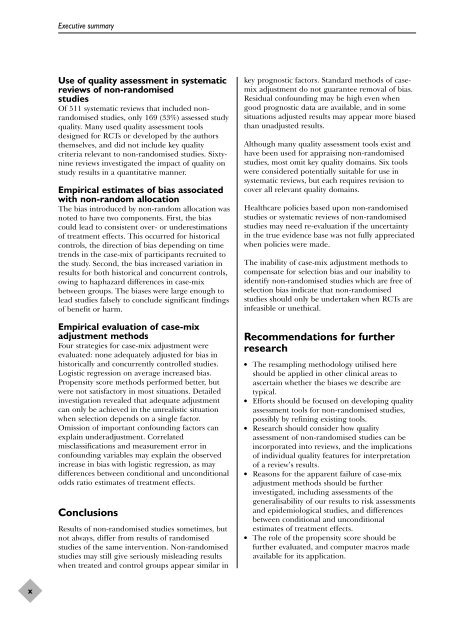Evaluating non-randomised intervention studies - NIHR Health ...
Evaluating non-randomised intervention studies - NIHR Health ...
Evaluating non-randomised intervention studies - NIHR Health ...
Create successful ePaper yourself
Turn your PDF publications into a flip-book with our unique Google optimized e-Paper software.
Executive summaryUse of quality assessment in systematicreviews of <strong>non</strong>-<strong>randomised</strong><strong>studies</strong>Of 511 systematic reviews that included <strong>non</strong><strong>randomised</strong><strong>studies</strong>, only 169 (33%) assessed studyquality. Many used quality assessment toolsdesigned for RCTs or developed by the authorsthemselves, and did not include key qualitycriteria relevant to <strong>non</strong>-<strong>randomised</strong> <strong>studies</strong>. Sixtyninereviews investigated the impact of quality onstudy results in a quantitative manner.Empirical estimates of bias associatedwith <strong>non</strong>-random allocationThe bias introduced by <strong>non</strong>-random allocation wasnoted to have two components. First, the biascould lead to consistent over- or underestimationsof treatment effects. This occurred for historicalcontrols, the direction of bias depending on timetrends in the case-mix of participants recruited tothe study. Second, the bias increased variation inresults for both historical and concurrent controls,owing to haphazard differences in case-mixbetween groups. The biases were large enough tolead <strong>studies</strong> falsely to conclude significant findingsof benefit or harm.Empirical evaluation of case-mixadjustment methodsFour strategies for case-mix adjustment wereevaluated: <strong>non</strong>e adequately adjusted for bias inhistorically and concurrently controlled <strong>studies</strong>.Logistic regression on average increased bias.Propensity score methods performed better, butwere not satisfactory in most situations. Detailedinvestigation revealed that adequate adjustmentcan only be achieved in the unrealistic situationwhen selection depends on a single factor.Omission of important confounding factors canexplain underadjustment. Correlatedmisclassifications and measurement error inconfounding variables may explain the observedincrease in bias with logistic regression, as maydifferences between conditional and unconditionalodds ratio estimates of treatment effects.ConclusionsResults of <strong>non</strong>-<strong>randomised</strong> <strong>studies</strong> sometimes, butnot always, differ from results of <strong>randomised</strong><strong>studies</strong> of the same <strong>intervention</strong>. Non-<strong>randomised</strong><strong>studies</strong> may still give seriously misleading resultswhen treated and control groups appear similar inkey prognostic factors. Standard methods of casemixadjustment do not guarantee removal of bias.Residual confounding may be high even whengood prognostic data are available, and in somesituations adjusted results may appear more biasedthan unadjusted results.Although many quality assessment tools exist andhave been used for appraising <strong>non</strong>-<strong>randomised</strong><strong>studies</strong>, most omit key quality domains. Six toolswere considered potentially suitable for use insystematic reviews, but each requires revision tocover all relevant quality domains.<strong>Health</strong>care policies based upon <strong>non</strong>-<strong>randomised</strong><strong>studies</strong> or systematic reviews of <strong>non</strong>-<strong>randomised</strong><strong>studies</strong> may need re-evaluation if the uncertaintyin the true evidence base was not fully appreciatedwhen policies were made.The inability of case-mix adjustment methods tocompensate for selection bias and our inability toidentify <strong>non</strong>-<strong>randomised</strong> <strong>studies</strong> which are free ofselection bias indicate that <strong>non</strong>-<strong>randomised</strong><strong>studies</strong> should only be undertaken when RCTs areinfeasible or unethical.Recommendations for furtherresearch●●●●●The resampling methodology utilised hereshould be applied in other clinical areas toascertain whether the biases we describe aretypical.Efforts should be focused on developing qualityassessment tools for <strong>non</strong>-<strong>randomised</strong> <strong>studies</strong>,possibly by refining existing tools.Research should consider how qualityassessment of <strong>non</strong>-<strong>randomised</strong> <strong>studies</strong> can beincorporated into reviews, and the implicationsof individual quality features for interpretationof a review’s results.Reasons for the apparent failure of case-mixadjustment methods should be furtherinvestigated, including assessments of thegeneralisability of our results to risk assessmentsand epidemiological <strong>studies</strong>, and differencesbetween conditional and unconditionalestimates of treatment effects.The role of the propensity score should befurther evaluated, and computer macros madeavailable for its application.x
















